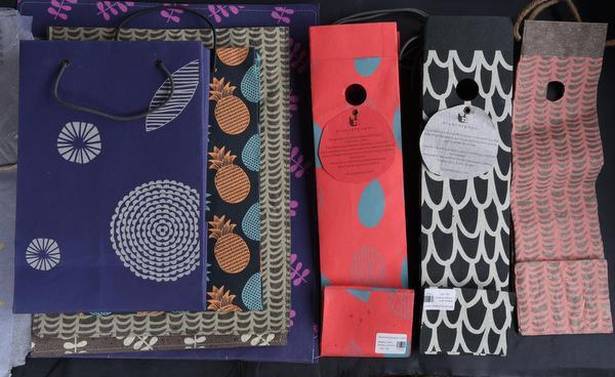
Instead of wood pulp, Bluecat Paper uses cotton, linen rags, coffee husk, banana fibre, mulberry, corn husk and flax fibre among other things
Kavya Madappa’s cabin at Bluecat Paper, a company that makes upcycled paper, overlooks a small verdant garden with a passion fruit vine and other plants. A black native dog sleeps on a thick sheet that is spread on a plush couch. It is not her pet. “He just likes to hang out here,” says Kavya from her desk. The office, located in Peenya, is airy, green and relaxing — it is unsurprising that Kavya also owns a spa resort in Coorg.
“I grew up in Coorg. Having a large backyard with lots of trees is something I took for granted,” she says. When she moved to Bengaluru, it took a while to adjust to the city’s traffic and bustle. Most conspicuous — and disturbing — to her, however, was the rapid felling of trees. She realised this when she happened to witness the large-scale production of paper at a mill.
Paper is mostly produced from wood pulp, which requires sawing of timber and removal of bark. Environmental activist Mandy Haggith, in her book Paper Trails: From Trees to Trash – The True Cost of Paper, writes: “The paper industry consumes 42% of all the wood felled industrially every year and its share of the world’s cleared forest is an area of about three million hectares annually.”
According to worldatlas.com, in the past four decades, the use of paper has risen by 400%. Roughly 26% of solid waste dumped in dumping sites is discarded paper and paperboard. A report by the Food and Agriculture Organisation of the United Nations says that by 2050, more than half of the world’s total demand for wood and wood products is likely to consist of paper and paper products.

These numbers suggest that Kavya’s concern for trees at the paper mill wasn’t misplaced. She sought and found a way to make paper without wood pulp. For two years, she studied about paper, met papermakers and experimented with different methods. A 15-day hand papermaking course at the Kumarappa National Handmade Paper Institute in Jaipur equipped her to set up Bluecat Paper in 2018.
Instead of wood pulp, Bluecat Paper uses cotton, linen rags, coffee husk, banana fibre, mulberry, corn husk and flax fibre among other things to make paper. These raw materials, according to Kavya, are abundant. Even the quality of her “tree-free paper”, she assures, is as good as the ones made from wood pulp. But handmade papers are expensive as their production is labour- and time-intensive.
“Most machines are developed for rolls of paper, whereas handmade paper is made into sheets,” explains Kavya. She, however, hopes that “tree-free paper” becomes mainstream. “I had to scale it up because most of the hand papermakers I knew were making paper in their backyard or in small units. At Bluecat, we can make 5,000 to 6,000 sheets of paper a day,” she says. But this number is a trifle compared to the lakhs of sheets manufactured at a paper mill every day.
“Paper isn’t a big deal,” says Kavya, “It is use and throw. You don’t even think you are wasting paper because it is cheap… But it comes at a price for planet Earth.”
Kavya steps out of her cabin to pluck a raw passion fruit. “A tree needs to grow at least 20 years before it can be cut for paper. But by this time, it has its own little ecosystem.But one fine day, you come and cut 50,000 trees at one go and say, ‘It is okay’… Come on, it’s ridiculous!”
(Bluecat’s products are available on bluecatpaper.com and leading e-commerce sites)
source: http://www.thehindu.com / The Hindu / Home> News> Cities> Bengaluru / by Praveen Sudevan / September 26th, 2019

